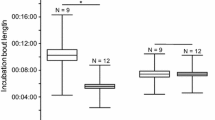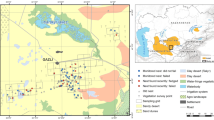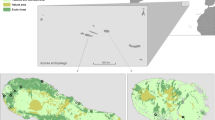Abstract
Predation is a major ecological and evolutionary driver of natural populations, greatly influencing fitness and behaviour of prey species. Small, long-lived petrels are vulnerable to predation at the breeding colonies and are expected to evolve behavioural strategies to minimize predation risks. Using an automatic nest monitoring system and nightly aerial counts, we examined the effect of vegetation cover and moonlight on colony attendance patterns and levels of burrow activity of breeding thin-billed prions, Pachyptila belcheri, on New Island, Falkland Islands. We further investigated how these parameters were related to predation by Falkland skuas. We monitored up to 32 nests in two habitats, one with Tussock grass and one with low vegetation cover. Individuals in both areas were more active at the nest before hatching, and those breeding in the low cover habitat were more active and arrived at the colony earlier, which might reflect an effect of reaction time over predation risk. Nocturnal activity peaks shifted in time as the season progressed, indicating behavioural adjustments to sunrise hours. Moon phase did not affect attendance and activity levels of breeders in either habitat or overall aerial activity, but influenced arrival time at the colony during chick-rearing, individuals arriving later in periods of full moon. Skua capture rates were positively correlated with aerial and nest activity but not with overall breeder attendance and were unaffected by moon phase. Thin-billed prions activity budgets are influenced by environmental parameters that affect their likelihood of being predated.




Similar content being viewed by others
References
Boersma PD, Davies EM (1987) Sexing monomorphic birds by vent measurements. Auk 104:779–783
Boersma PD, Silva MC (2001) Fork-tailed storm-petrel (Oceanodroma furcata). In: Poole A, Gill F (eds) The Birds of North America. Birds of North America, Philadelphia, no. 569
Boersma PD, Wheelwright NT, Nerini MK, Wheelwright ES (1980) The breeding biology of the fork-tailed storm-petrel (Oceanodroma furcata). Auk 97:268–282
Bretagnolle V (1990) Effet de la lune sur l’activité des petrels (classe Aves) aux îles selvages (Portugal). Can J Zool 68:1404–1409
Bretagnolle V, Genevois F, Mougeot F (1998) Intra- and inter-sexual functions in the call of a non-passerine bird. Behaviour 135:1161–1184
Catry P, Campos A, Segurado P, Silva MC, Strange IJ (2003) Population census and nesting habitat selection if thin-billed prion Pachyptila belcheri on New Island, Falkland Islands. Polar Biol 26:202–207
Catry P, Silva MC, MacKay S, Campos A, Masello J, Quillfeldt P, Strange IJ (2007) Can thin-billed prions Pachyptila belcheri breed successfully on an island with introduced rats, mice and cats? The case of New Island, Falkland Islands. Polar Biol 30:391–394
Chastel O, Weimerskirch H, Jouventin P (1995) Body condition and seabird reproductive performance: a study of three petrel species. Ecology 76:2240–2246
de Brooke ML, and Prince PA (1991) Nocturnality in seabirds. Proc Int Orn Congres XX:1113–1121
Duriez O (2000) Regulation of chick provisioning in the thin-billed prion: an interannual comparison and manipulation of parents. Can J Zool 78:1275–1283
Granadeiro JP, Burns MD, Furness RW (1998) Patterns of activity and burrow attendance in Cory’s Shearwater Calonectris diomedea as revealed by a novel logging technique. Ibis 140:458–466
Harfenist A, Ydenberg RC (1995) Parental provisioning and predation risk in rhinoceros auklets (Cerorhinca monocerata): effects on nestling growth and fledging. Behav Ecol 6:82–86
Harris MP (1969) The biology of storm-petrels in the Galapagos Islands. Proc Calif Acad Sci 37:95–166
Huntington CE, Butler RG, Mauck RA (1996) Leach’s storm-petrel (Oceanodroma leucorrhoa). In: Poole A, Gill F (eds) The Birds of North America. Birds of North America, Philadelphia, no. 233
Imber MJ (1975) Behaviour of petrels in relation to the moon and artificial lights. Notornis 22:302–306
Keitt BS, Tershy BR, Croll DA (2004) Nocturnal behavior reduces predation pressure on black-vented shearwaters Puffinus opisthomelas. Mar Ornithol 32:173–178
Klomp NI, Furness RW (1992) Patterns of chick feeding in Cory’s Shearwater and the associations with ambient light. Colon Waterbirds 15:95–102
Lima SL (1998) Stress and decision-making under the risk of predation: recent developments from behavioral, reproductive and ecological perspectives. Adv Study Behav 27:215–290
Lima SL, Dill LM (1990) Behavioral decisions made under the risk of predation: a review and prospectus. Can J Zool 68:619–640
Marchant S, Higgins PJ (eds) (1990) The handbook of Australian, New Zealand and Antarctic Birds. Oxford University Press, Melbourne
Martin TE (1996) Nest predation and avian life-history evolution in Europe versus North America: a possible role for humans? Am Nat 147:1028–1046
Miyazaki M (1996) Vegetation cover, kleptoparasitism by diurnal gulls, and timing of arrival of nocturnal Rhinoceros Auklets. Auk 113:698–702
Mougeot F, Bretagnolle V (2000a) Predation as a cost of sexual communication in nocturnal seabirds: an experimental approach using acoustic signals. Anim Behav 60:647–656
Mougeot F, Bretagnolle V (2000b) Predation risk and moonlight avoidance in nocturnal seabirds. J Avian Biol 31:376–386
Mougeot F, Genevois F, Bretagnolle V (1998) Predation on burrowing petrels by the brown skua (Catharacta skua lonnbergi) at Mayes Island, Kerguelen. J Zool 244:429–438
Nordstrom M, Korpimaki E (2004) Effects of island isolation and feral mink removal on bird communities on small islands in the Baltic Sea. J Anim Ecol 73:424–433
Phalan B, Phillips RA, Silk JRD, Afanasyev V, Fukuda A, Fox J, Catry P, Higuchi H, Croxall JP (2007) Foraging behaviour of four albatross species by night and day. MEPS 340:271–286
Pierotti R (1982) Habitat selection and its effect on reproductive output in the Herring gull in Newfoundland. Ecology 63:854–868
Pinheiro J, Bates D, DebRoy S, Sarkar D, R. Core team (2009) nlme: linear and nonlinear mixed effects models. R Package Version 3:1–92
Quillfeldt P, Maselalo J, Strange IJ, Buchanan KL (2006) Begging and provisioning of thin-billed prions, Pachyptila belcheri, are related to testorone and corticosterone. Anim Behav 71:1359–1369
Silva MC, Boersma PD, MacKay S, Strange IJ (2007) Egg size and parental quality in thin-billed prions, Pachyptila belcheri: effects on offspring fitness. Anim Behav 74:1403–1412
Storey AE, Grimmer BL (1986) Effect of illumination on the nocturnal activities of Manx Shearwaters: colony avoidance or inconspicuous behavior? Bird Behav 6:85–89
Strange IJ (1980) The thin-billed prion, Pachyptila belcheri, at New Island, Falkland Islands. Le Gerfaut 70:411–445
Wanless RM, Angel A, Cuthbert RJ, Hilton GM, Ryan PG (2007) Can predation by invasive mice drive seabird extinctions? Biol Lett 3:241–244
Warham J (1990) The petrels. Their ecology and breeding systems. Academic Press, London
Warham J (1996) The behaviour. Population biology and physiology of the petrels. Academic Press, London
Watanuki Y (1986) Moonlight avoidance behavior in leach’s storm-petrels as a defense against slaty-backed Gulls. Auk 103:14–22
Watanuki Y (2002) Moonlight and activity of breeders and non-breeders of Leach′s storm-petrels. J Yamashina Inst Ornithol 34:245–249
Weidinger K (1998) Effect of predation by skuas on breeding success of the Cape petrel Daption capense at Nelson Island, Antarctica. Polar Biol 20:170–177
Yamamoto T, Takahashi A, Yoda K, Katsumata N, Watanabe S, Sato K, Trathan PN (2008) The lunar cycle affects at-sea behaviour in a pelagic seabird, the streaked shearwater, Calonectris leucomelas. Anim Behav 76:1647–1652
Young EC (1976) Behavioural ecology of lonnbergi skuas in relation to environment on the Chatham Islands. NZ J Zool 5:401–416
Acknowledgments
The authors are grateful to S. MacKay for invaluable help with fieldwork, database organization and review of early versions of the manuscript. We are also grateful to the Physics Department, University of Washington, for access to equipment necessary to roll the coils, and to M. Burns, University of Glasgow for help with system maintenance. We thank the owners and crew of the “Professor Molchanov” for transportation to New Island. P Catry provided useful comments on the manuscript. Funding was provided by grants from Fundação para a Ciência e a Tecnologia (BD/9356/96 and BPD/22276/05) to MCS and also by the project Albatroz (PTDC/MAR/099366/2008). We also thank the New Island Conservation Trust, Falkland Islands Government and Wildlife Conservation Society for support.
Author information
Authors and Affiliations
Corresponding author
Rights and permissions
About this article
Cite this article
Silva, M.C., Granadeiro, J.P., Boersma, P.D. et al. Effects of predation risk on the nocturnal activity budgets of thin-billed prions Pachyptila belcheri on New Island, Falkland Islands. Polar Biol 34, 421–429 (2011). https://doi.org/10.1007/s00300-010-0897-6
Received:
Revised:
Accepted:
Published:
Issue Date:
DOI: https://doi.org/10.1007/s00300-010-0897-6




